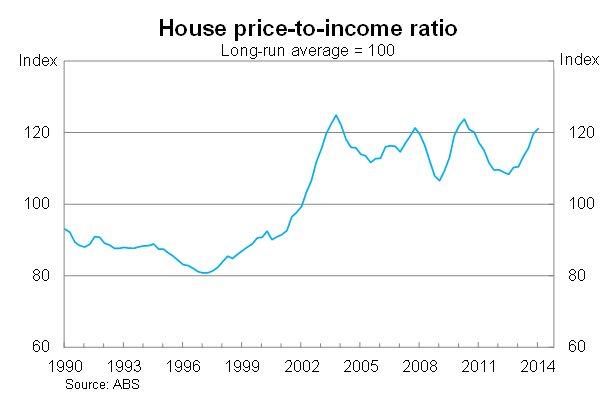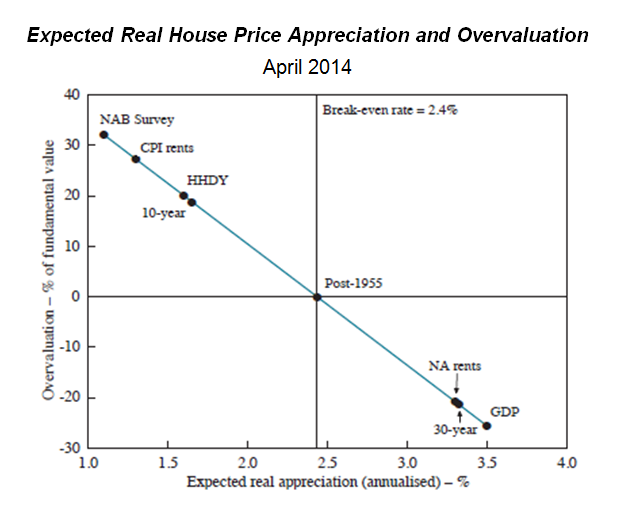The great Australian housing rip-off
Owning your own home remains a dream for many Australians, but an increasingly difficult one. In our pursuit of home ownership we are frequently ripped off, with new evidence from the Reserve Bank of Australia suggesting that housing is severely overvalued. Combined with a soft economic outlook, younger Australians would be well advised to think hard before taking on excess leverage, borrowing from their parents and entering Australia’s housing market.
The RBA released an interesting research paper yesterday on housing valuation by economists Ryan Fox and Peter Tulip. They ask the pivotal question: Is housing overvalued?
I have addressed housing valuation a few times during my tenure at Business Spectator. My general view is that Australians are frequently ripped off when purchasing a home. A combination of poor housing policy -- including negative gearing, capital gains tax concessions or exemptions and the first-home owner grant -- combined with housing supply restrictions, excessive bank lending and stamp duty have resulted in arguably the most expensive housing stock in the world.
And yet Australians keep buying homes, at increasing values and with increasing levels of mortgage debt. Some argue that it is a bubble but many Australians believe they are getting a good deal.
Fox and Tulip have taken an opportunity cost approach to home ownership. A house is considered ‘overvalued’ if the individual would be better off renting the home compared with owning a similar dwelling.
Should you rent or buy? It’s an age old question but one with a simple answer for most Australians: “Of course you should buy!” Yet it is far from a no-brainer, as the analysis from Fox and Tulip shows.
It is important to note that the decision to rent or buy excludes the decision of whether to become a property investor. Investors face a very different set of trade-offs compared with those contemplating home ownership.
In fact, based on the rampant speculation in the Sydney and Melbourne housing markets, and the low rental yields on residential property, I’d wager that there is only one consideration for many housing investors: expectations of massive capital gains.
The goal of Fox and Tulip’s analysis is to create a superior method of valuation compared with measures such as the house price-to-income and house price-to-rent ratios. Both these measures are simple but have some obvious limitations.
Both ratios have also increased significantly over the past few decades, resulting in organisations such as the International Monetary Fund and Organisation for Economic Co-operation and Development declaring that Australian house prices are significantly overvalued (Why Australia is floored by sky-high house prices, June 13).
Fox and Tulip argue that an upward trending price-to-income ratio is not surprising. They suggest that it is to be expected when land is in limited supply; prices need to rise faster than incomes to keep demand in line with supply.
Land supply is an important determinant of house prices but I’d like to flip their argument around. Rather than attributing the upward trend to supply restrictions, I’d place the blame on the willingness of our banks to lend.
House price multiples began to increase at a rapid pace when the Australian banking system was deregulated, lifting the shackles from households and removing the credit rationing that had plagued our banking system.

Although they are often ignored, banks determine the level of house prices by sheer virtue of the fact that they control the purse-strings. They could create a house-price bubble or bust by simply changing their tolerance to risk.
House price multiples increased because of greater access to credit, with supply restrictions playing a more modest role. More importantly, this reflected a one-off structural shift to Australian housing; it would be a mistake to assume that it was part of a broader trend or indicative that house price multiples will increase indefinitely.
But returning to their model, Fox and Tulip compare the cost of renting against purchasing a home using a matched sample of properties. This controls for issues of quality changing over time.
They find that the decision to buy or rent is highly sensitive to one’s expectations regarding capital appreciation. Their base scenario assumes that house prices will continue to grow at their post-1955 average, during which time real house prices rose by 2.4 per cent annually. Under this scenario, housing is perfectly priced compared with rents.
But as I’ve argued frequently it is unreasonable to assume that future house price growth will match past gains. Banking deregulation ushered in a period of structural change in lending markets that cannot be replicated. Prices boomed on the back of rising mortgage lending and that provided a one-off boost to house prices.
Wisely, Fox and Tulip explore a range of other scenarios. The sensitivity of their analysis to various price growth assumptions is contained in the graph below.

I expect that the media will focus on the base scenario -- the post-1955 average -- but in doing so they will severely overestimate house price growth over the next couple of decades. Structural shifts in the Australian economy resulting from an ageing population and a declining terms of trade, combined with the Chinese economy slowing, will weigh on income and price growth, while high levels of indebtedness should place a speed limit on potential growth.
The most interesting scenario considered by Fox and Tulip is the scenario where real house prices grow at the rate of household income growth (denoted in the graph by “HHDY”). This scenario is perhaps a little optimistic (the risks to income growth are on the downside) but it approximates our current reality since the house price-to-income ratio has been relatively stable -- by which I mean fluctuating around a constant mean -- over the past decade. Under this scenario, housing is overvalued by around 20 per cent.
The great Australian dream might be to own your own home but financially it no longer makes sense for many Australians. The research by Fox and Tulip, using plausible assumptions for price growth, suggests that housing is severely overvalued in Australia and many Australians are getting ripped off. By comparison, rents remain relatively cheap and are a better option for many younger Australians who have yet to dip their toes into the murky waters of Australia’s property market.
















